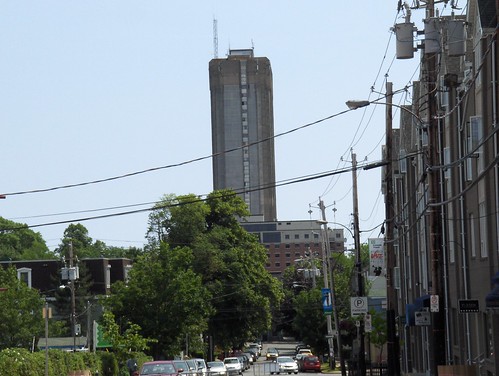
For the next month, Spacing Atlantic will engage in an in-depth analysis of HRMbyDesign, the ambitious plan set fourth by the municipal government to transform the region over the next 25 years. This series of weekly installments will move through the plan’s various nooks and crannies, and carve out a unique and fresh perspective on the HRMbyDesign process.
________________________________________________________________________
HALIFAX – The language of the Downtown Halifax Secondary Regional Planning Strategy (Downtown Plan) places great emphasis on environmental sustainability. The plan views sustainability as “[a] fundamental underpinning of the design approach to the Regional Center and downtown Halifax.” In spite of the high value that HRM places on sustainability, the Downtown Plan in its current form falls flat on this particular issue in a few ways.
One way that HRMbyDesign says the downtown can move towards greater sustainability is by improving public infrastructure in ways that encourage walking, cycling and use of public transit. I’ll be focusing on the cycling and pubic transit implications of HRMbyDesign in next week’s installment, so for now let’s hone in on the pedestrian elements of the plan.
HRMbyDesign’s plan to improve the downtown pedestrian experience is probably one of their most successful. The mixed-use approach to zoning is intended to create the type of shopping, living and working environments that lend themselves well to a pedestrian lifestyle. The Downtown Plan is also designating certain parts of the downtown as ‘pedestrian-oriented commercial streetscapes.’ This means that the City will be creating certain rules through the Land Use By-Law [PDF] that will “establish requirements for active ground floor uses along these streets.”
On the pedestrian front I give HRM some credit. It sounds like they’ll be making some real improvements that will make it nicer and more practical to get around downtown on foot. Unfortunately, I feel the rest of the plan falls a little short of the City’s stated goals.
To have a truly sustainable Halifax, there can be little argument that the city’s buildings need to be more efficient. The Downtown Plan recognizes this — to an extent. The plan encourages developing and renovating buildings to achieve LEED certification standards.
From the City’s perspective there is good reason for this. According to the Downtown Plan, HRM does not have the legal authority to make the changes to the provincial building code legislation that would be required to make sustainable design standards mandatory. Andy Fillmore, urban design project manager for the Capital District, says that we will see these kinds of requirements put in place as soon as the necessary changes occur at the provincial level.
Jen Powley of the Ecology Action Center says that the city shouldn’t have to wait for the province to change the building code. She believes that they have the authority now, but just don’t want to do it. When I asked her why she thought that was, she responded, “they may be worried about litigation.”
Powley has some pretty good evidence to support this claim. In a June 2009 press release, the Ecology Action Center proposed an amendment to HRMbyDesign that development projects should have to meet a LEED silver rating to qualify for bonus zoning. Bonus zoning is an element of the Downtown Plan where developers have the opportunity to exceed the normal maximum building height in exchange for the provision of public benefit. This can include things like subsidized housing units, public art, and subsidized commercial space for arts and cultural uses or child care centers, among other things. In response to this amendment, HRM stated that “[t]he overall objective of HRMbyDesign is to make the development process easier and less prone to appeals and litigation,” and that there was some concern that this amendment may slow down the whole approval process.
While the Downtown Plan seems totally lacking in this area as far as private development is concerned, it does use stronger language when discussing future public development projects. The plan states that it’s the “intention of the HRM to ensure that all new municipal facilities are designed to show leadership in sustainable building design.” It also says that the HRM intends to negotiate an agreement with the provincial and federal governments and other agencies to ensure that the development of all public lands in Halifax complies with LEED standards. My inner cynic is somewhat skeptical of the use of the word ‘intention.’ Maybe it’s me, but it just doesn’t sound all that binding.
In defence of HRM, they do seem to be legitimately working towards imposing environmental regulations on building projects in the future. What concerns environmental activists like Powley is that the regulations aren’t coming quickly enough. “If it takes a year or two to come up with environmental building regulations — which is the best estimate — that’s a lot of development that can happen in that time,” Powley says, adding that it’s important to remember that buildings constructed today will stand for many years to come: “If nothing is done right now than that’s a 50 year legacy of pollution that will be left.”
That’s all for now, next week I’ll be taking a look at transportation.
Photo By Sean Micallef
